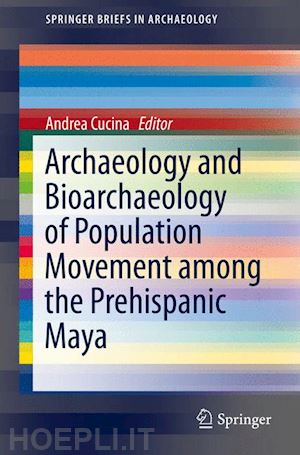

Questo prodotto usufruisce delle SPEDIZIONI GRATIS
selezionando l'opzione Corriere Veloce in fase di ordine.
Pagabile anche con Carta della cultura giovani e del merito, 18App Bonus Cultura e Carta del Docente
Archaeological evidence - i.e. presence of exogenous, foreign material objects (pottery, obsidian and so on) - is used to make inferences on ancient trade, while population movement can only be assessed when the biological component of an ancient community is analyzed (i.e. the human skeletal remains). But the exchange of goods or the presence of foreign architectural patterns does not necessarily imply genetic admixture between groups, while at the same time humans can migrate for reasons that may not be related only to trading. The Prehispanic Maya were a complex, highly stratified society. During the Classic period, city-states governed over large regions, establishing complex ties of alliance and commerce with the region’s minor centers and their allies, against other city-states within and outside the Maya realm. The fall of the political system during the Classic period (the Maya collapse) led to hypothetical invasions of leading groups from the Gulf of Mexico into the northern Maya lowland at the onset of the Postclassic. However, it is still unclear whether this collapse was already underway when this movement of people started. The whole picture of population dynamics in Maya Prehispanic times, during the Classic and the Postclassic, can slowly emerge only when all the pieces of the puzzle are put together in a holistic and multidisciplinary fashion.
The contributions of this volume bring together contributions from archaeology, archaeometry, paleodemography and bioarchaeology. They provide an initial account of the dynamic qualities behind large–scale ancient population dynamics, and at the same time represent novel multidisciplinary points of departure towards an integrated reconstruction and understanding of Prehispanic population dynamics in the Maya region.
Introduction. Andrea Cucina.- Chapter 1: Xcambo and its Commercial Dynamics Within the Framework of the Maya Area. Thelma N. Sierra Sosa.- Chapter 2: Ceramic Traditions in the Calakmul Region: An Indicator of the Movement of Ideas or Populations? María del Rosario Domínguez Carrasco & William J. Folan.- Chapter 3: Cultural Interchange Regarding the Distribution of Fine Paste Ceramics Within Riverine Societies Along the Usumacinta’s Mid to Low Basin and Various Gulf Coast’s Communities. Socorro del Pilar Jiménez Alvarez.- Chapter 4: Calakmul: Power, Perseverance and Persistence. William J. Folan, Maria del Rosario Domínguez Carrasco, Joel D. Gunn, Abel Morales L., Raymundo González H., Gerardo Villanueva García & Nuría Torrescano Valle.- Chapter 5: The Historic Presence of Itza, Putun and Toltec in the Maya Lowlands at the End of the Classic and Postclassic Periods. Rafael Cobos.- Chapter 6: The Use of Theoretical and Methodological Bases in Population Movements’ Studies: Paleo and Archaeo Demographic Approaches. Allan Ortega Muñoz.- Chapter 7: Population Dynamics during the Classic and Postclassic Period Maya in the Northern Maya Lowlands: The Analysis of Dental Morphological Traits. Andrea Cucina.- Chapter 8:The Buk Phase Burials of Belize: Testing Genetic Relatedness Among Early Postclassic Groups in Northern Belize Using Dental Morphology. Gabriel Wrobel & Elizabeth Graham.- Chapter 9: Dental Nonmetric Investigation of Population Dynamics at Mayapan. Stanley Serafin, Carlos Peraza Lope & Andrea Cucina.- Chapter 10: Dental Morphometric and Strontium Isotope Evidence for Population History at Tikal, Guatemala. Andrew K. Scherer & Lori E. Wright.- Chapter 11: Strontium Isotopes and the Study of Human Mobility Among the Ancient Maya. T. Douglas Price, James H. Burton, Paul D. Fullagar, Lori E. Wright, Jane E. Buikstra & Vera Tiesler.-Chapter 12: House Or Lineage? How Intracemetery Kinship Analysis. Contributes To The Debate In The Maya Area. William N. Duncan & Jon B. Hageman.- Chapter 13: Shifts in Artificial Head Forms, Population Movements, and Ethnicity Among the Postclassic Maya. Vera Tiesler.
Andrea Cucina
Doctorate degree in Paleopathology (1998), Catholic University of Rome, School of Medicine, Italy. Laurea (honoris) in Biological Sciences with a major in Physical anthropology, University of Rome La Sapienza. Currently, Full Professor at the School of Anthropological Sciences, Autonomous University of Yucatán in Merida, (Mexico). Member of the National System of Investigators Level II (Mexico). He has carried out field and lab research in Italy, Dominican Republic República, Pakistan, Florida, México and Guatemala. His main interest is in dental anthropology of extant and recent populations. Currently, it focuses on paleodiet, paleopathology, developmental stress and population dynamics of the ancient Mayas (though not exclusively), and the early colonizers on the New World, as well as on biodistance studies of pre- and proto-historic populations in Europe and South America. He is Book Review Editor of HOMO, Journal of Comparative Human Biology, and member of several academic international associations. He has authored or co-authored more than eighty scientific papers in international journals (American Journal of Physical Anthropology, Journal of Archaeological Sciences, Latin American Antiquity, NATURE, International Journal of Osteoarchaeology, HOMO and more), chapter in edited volumes, and has edited six books.











Il sito utilizza cookie ed altri strumenti di tracciamento che raccolgono informazioni dal dispositivo dell’utente. Oltre ai cookie tecnici ed analitici aggregati, strettamente necessari per il funzionamento di questo sito web, previo consenso dell’utente possono essere installati cookie di profilazione e marketing e cookie dei social media. Cliccando su “Accetto tutti i cookie” saranno attivate tutte le categorie di cookie. Per accettare solo deterninate categorie di cookie, cliccare invece su “Impostazioni cookie”. Chiudendo il banner o continuando a navigare saranno installati solo cookie tecnici. Per maggiori dettagli, consultare la Cookie Policy.